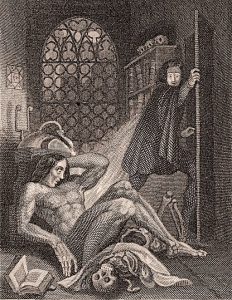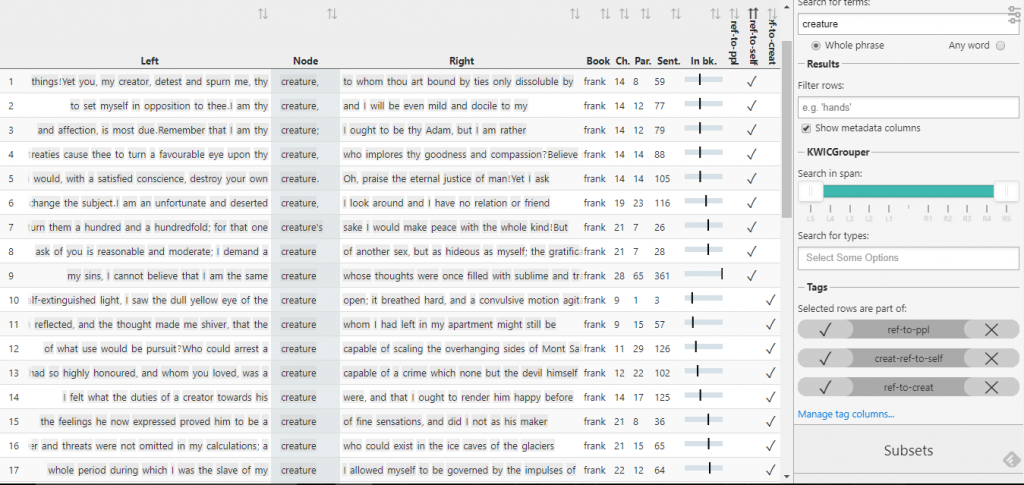Beth Kemp (@BethKemp on Twitter) is an English teacher, A Level examiner, teacher trainer and writer of textbooks and study guides for A Level, GCSE and KS3. She is also passionate about reading for pleasure and contemporary YA literature, finding that language and books of various kinds tend to dominate her work and her leisure.
Looking at GCSE Examiner’s Reports for both Literature and Language for the new qualification last year, it is quite obvious that the obsessive way in which many students are treating revision time as quote-cramming is not the best use of their time. Reports in all exams emphasise students need to engage with meaning, to interpret and, at the top end, to explore possible interpretations (preferably with reference to context) by close analysis. How useful, therefore, to be able to show students an alternative revision task in the classroom which they can pick up and continue to explore at home, as it is easily available online. I’m demonstrating here with Frankenstein, but the CLiC Dickens project has the full text of many of the set nineteenth-century texts. If you’re new to the project, I’d recommend looking at the CLiC Activity Book for other ideas of interesting and useful tasks that students can explore.
Looking at Labelling

Firstly, a nice simple task of looking at labels. Using the concordance, we can call up all 44 instances of the noun ‘creature’ and examine their immediate context. Students can work on grouping these in order to explore them in a bit more depth, considering questions such as ‘who is speaking?’, ‘do they all refer to the creature?’, ‘what connotations occur around the word?’ (e.g. by looking at adjectives and other nouns in each line). This task should help students to see how the word ‘creature’ is used throughout the novel and by whom.
In the image, I have used the ‘tag’ function to label the rows as the creature self-referencing, others labelling the creature or the word creature being used of people. Tags can be created for any purpose and within a class, different groups of students could be asked to organise the data differently (perhaps as a means of differentiation, with the more able exploring connotations over the simpler concepts of who says what about whom). [Editorial comment: for another example of using tags, see a previous post on this blog analysing Conrad’s Heart of Darkness.]

A similar search can be repeated to look at the 31 instances of the word ‘monster’, but this time a close look at associated pronouns is particularly revealing, as this noun occurs frequently with ‘you’ or ‘I’ or even ‘thy’, showing how this noun is used to label and question identity. It also appears only from chapter 9 to the end, whereas ‘creature’ is used even before the creature’s appearance in chapter 9. If students wish, the same task can also be repeated with the noun ‘wretch’ for further exploration.
Characters and Qualities
Students can explore the associations with character names by using the concordance to search for the names and looking for words that frequently appear as collocates with the names. For example, the adjective ‘innocent’ appears alongside six of the fifty-five instances of ‘Justine’. This can be tested by using the ‘filter’ box to enter words which students might expect to see in the same dataset as the target name.
Exploring Themes and Message
Searching for abstract nouns associated with theme is also a valuable task, to look for points in the text where the author discusses them explicitly. For example, in Frankenstein, Shelley uses the word ‘glory’ only seven times: in chapters 1, 2, 5, 6, 19 and twice in chapter 28. Students might reasonably be asked to consider why this clustering at the beginning and end occurs, and to comment on the sentences which the concordance brings up for this search. Other relevant concepts they might also search for include ‘creation’, ‘justice’, ‘science’ or contextual ideas such as ‘galvanism’, ‘sublime’ or ‘horror’ – all are included at least once and can be explored in the micro-context to extend as well as test students’ knowledge of the text.
Engaging with meaning throughout the whole text
Hopefully, this has demonstrated how CLiC can help students to engage meaningfully with the whole text and develop their knowledge of key aspects of it while also demonstrating that knowledge. The support offered by the corpus allows students to safely explore and to show some knowledge, enabling them to boost their confidence by making valid and informed comments (beyond the often obvious and superficial that we tend to get when they panic looking at an extract) in this critical time.
Please cite this post as follows: Kemp, B. (2018, April 5). Revising Frankenstein with CLiC Dickens [Blog post]. Retrieved from https://blog.bham.ac.uk/clic-dickens/2018/03/27/whats-in-a-word-revision-with-clic

Join the discussion
0 people are already talking about this, why not let us know what you think?